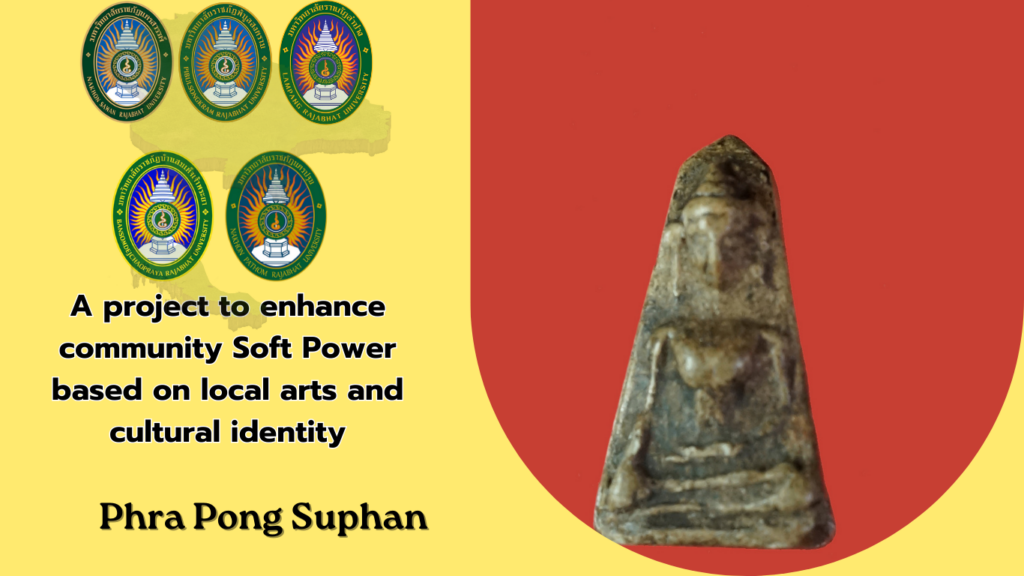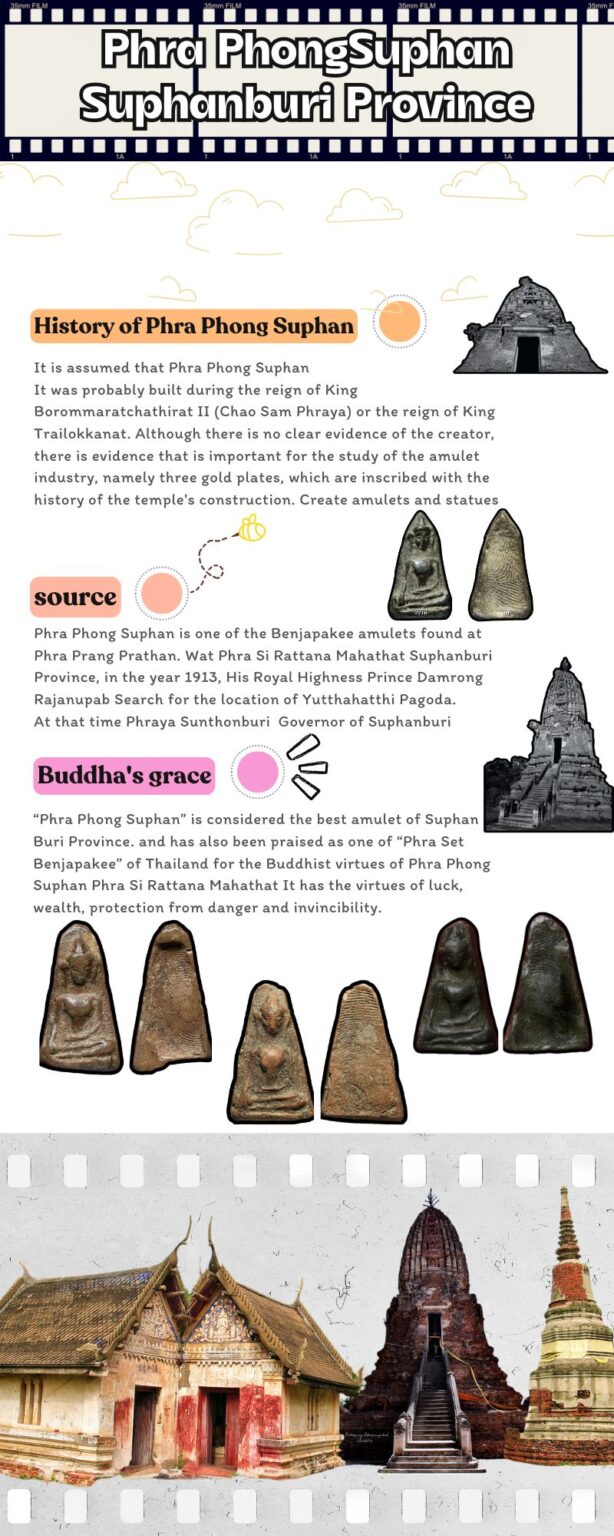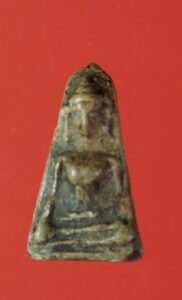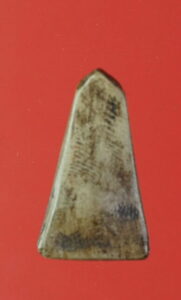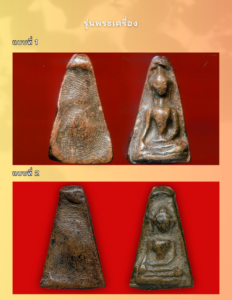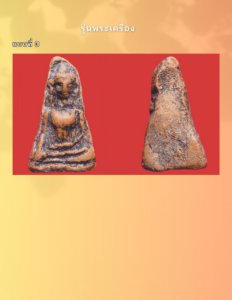The Sacredness and Legend of the Phra Pong Suphan from the Wat Phra Si Rattana Mahathat Temple.
The spiritual power of the Phra Pong Suphan from the Wat Phra Si Rattana Mahathat Temple in Suphan Buri has been famous since ancient times, as evidenced by the golden inscription found in the temple's crypt, which has been copied into six copies. The inscription details the methods of creation and the "upate," which refers to the rituals for invoking the Buddha's assistance in various situations. For example, it is said that no matter how dangerous the situation may be, one should invite the Buddha to be placed on the head or tied around the neck, and all dangers will be eliminated. Furthermore, if one is about to go to war, it is advised to bathe the Buddha in fragrant oil, consecrate it with the nine-fold blessing, and then use the fragrant oil in the hair, which will ensure the success of the endeavor.
The Legend of Phra Pong Suphan.
The copy of the golden inscription found mentions the creation of Phra Pong Suphan as follows:
"Subhamasadu 1265 Sittikarika states that the four hermits, with the head hermit Phimpilalai as the leader, decided to create the amulet using their mystical powers and tools, with gold being one of the materials. The great king, Phaya Sithathamso Kraratcha, was a devout believer, so the four hermits gathered to perform a ritual with the help of deities. They created the amulet in two types, one red and one black, by making powder from herbs and pressing them into molds with the hand of the revered monk Piyathat, who presided over the ceremony. Various minerals with different powers were used, and the ritual lasted for three months. Afterward, the amulets were placed in a stupa in Phantum city.
Anyone who finds these amulets should keep them for worship as a precious item. No matter the danger, tying the amulet around one's neck will protect them from all harm. To further empower it, the amulet should be bathed in fragrant oil while reciting the mantras of the Buddha, Dharma, and Sangha 108 times, the Phahung mantra 13 times, and applying it to the face, chest, neck, and hair. If used for compassion, it will enhance one's dignity and make others listen and respect them.
The amulet should be kept in fragrant oil, empowered with the Nanawara mantra 13 times, the Phahung mantra 13 times, and the Buddha mantra 13 times. Flowers, incense, and candles should be used in a ceremony on a Saturday. The fragrant oil can be used to anoint the lips, forehead, and hair. If one encounters any of these amulets—whether they are made of herbs, hair, or sanctified minerals—they should never be treated with disrespect, as the power of all three types of amulets acts like a protective wall, guarding against all dangers. One should then recite the following mantras to protect from harm, concluding with the Buddha, Dharma, and Sangha mantras, the Phahung mantra, and finishing with the phrases:
"Gatesika, Karana, Maha Chaiyā, Mangga, Sannama Phatha," followed by "Kirimiti, Gurumuthu, Geremethe, Karamata Prasitti."
The Miraculous Powers of Phra Pong Suphan.
In the past, people in Suphanburi were fond of the sport of buffalo fighting, betting money and gold, and playing it frequently. At that time, Phra Pong Suphan was abundant and had no value (monetary worth) like it does today. Therefore, broken pieces of Phra Pong Suphan amulets were ground into powder, mixed with grass, and fed to the buffaloes. When the buffaloes were sent into the fights, it was found that the buffaloes that had eaten the powdered Phra Pong Suphan fought exceptionally well, with strong and tough hide. It was truly a miraculous occurrence.
“Method of Invocation – Usage”
"Take Phra Pong Suphan and bathe it in scented water, then sit and chant the Three Jewels—Buddha, Dhamma, Sangha—108 times. Recite the 'Pahung' chant 3 times. Keep the scented oil for continuous use. If you wish to enhance the power further, hold your breath to concentrate and chant the following mantra to increase its potency:
‘Ka-te Lik Ge Ka-ra-nang Ma-ha Chai-yang Mang-ka-lang Na-ma-pa-ta Ki-ri-mi-ti Gu-ru-mu-thu Ge-re-me-the Ka-ra-ma-tha Pa-rat-thi-nak-le.’"
“Characteristics of Phra Pong Suphan”
-
The shape is triangular with a cut apex (cut with a stamp), including the side edges.
-
There is a type similar to Phra Nang Phaya, but it is very rare. The body is a Buddha image in the U-Thong art style.
-
The standard types are 3: the elderly face, the middle-aged face, and the youthful face.
-
The hair is layered in three levels. The ears droop, and the left ear has a bend inward. The base of the ear touches the head, resembling a goat’s ear. The chest resembles an elephant’s head. The abdomen is flat. The back shows traces of fingerprints on almost every piece.
-
Phra Pong Suphan comes in four different colors: 1. Black, 2. Red, 3. Green, 4. Dry Ficus. The Buddha’s power is especially beneficial for protection, auspiciousness, invulnerability, and overcoming dangers, as well as for ensuring safety and strong resilience.
